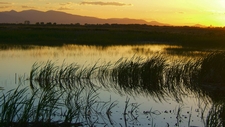Components of Ecosystems
Readiness

TEKS Objective
The student is expected to observe the way organisms live and survive in their ecosystem by interacting with the living and non-living elements.
Essential Understanding
The student knows that there are relationships, systems, and cycles within environments.
Science Background
Introduction to Ecosystems: BioEd Online (video) – Overview of the interactions among the components of ecosystems, cycles with ecosystems and basic types of ecosystems.
Introduction to Ecosystems
BioEd Online, www.bioedonline.org
The Concept of the Ecosystem: University of Michigan (website) -Detailed background information about ecosystems, covering topics such as processes that occur within ecosystems, living (biotic) and non-living (abiotic) components, transformation of energy, and more.
Habitats: World Wildlife Fund (website) - Overview of the major types of habitats, including information about the plants and animals that populate them.
Signature Lesson
Microclimate in the Schoolyard: National Geographic Xpeditions (website) - Students observe and compare conditions in their schoolyard to those of a prairie (Texas has many native prairie ecosystems, including the endangered coastal prairie).
Microclimate in the Schoolyard
National Geographic Xpeditions, www.nationalgeographic.com/xpeditions
- Supporting Lessons
- Extensions
- Assessment Ideas
- Literature Connections
- Related
TEKS - Additional Resources
Supporting Lessons
Ecosystem Comparison: Aquarium of the Pacific (PDF) - Students compare and contrast a coral reef and a kelp forest ecosystem, and identify the key living and non-living components of each system. Includes student sheets, discussion questions, extensions and answer keys.
Ecosystem Comparison
Aquarium of the Pacific, www.aquariumofpacific.org
Elaboration Lessons and Extensions
Habitat Breakdown: Texas A&M University (website) - Investigate the critical roles that food, water, shelter and space play in enabling organisms to survive in a given habitat. Includes assessment and math connections.
Assessment Ideas
Have students observe the microclimate in their own backyard or near their homes and compare their observations with the data obtained from obervations made around their school. Let them write a compare and contrast paper based on the similarities and differences between the two sites.
Literature Connections
Draw-Write-Now, Book 6: Animals and Habitats: On Land, Ponds and Rivers, Oceans. Hablitzel, Marie; Stitzer, Kim (ISBN-13: 978-0963930767)
Desert Giant: The World of the Saguaro Cactus. Bash, Barbara (ISBN-13: 978-1578050857)
Here is the African Savanna. Dunphy, Madeline (ISBN-13: 978-0977379521)
Journey into the Rain Forrest. Knight, Tim (ISBN-13: 978-0195217513)
Additional Resources
What’s It Like Where You Live: Missouri Botanical Garden (website) - Interactive website, appropriate for teachers and students, with information about the world’s major biomes and types of ecosystems.
What’s It Like Where You Live
Missouri Botanical Garden, mbgnet.net
Habitats, Home Sweet Home: National Geographic (website) - Collection of lesson plans and resources on different kinds of habitats (cities and suburbs, forests, oceans and coasts, etc.).
Habitats, Home Sweet Home
National Geographic, www.nationalgeographic.com
Where Does It Live? FOSSWEB (website) - Sort different organisms (e.g., rattlesnake, starfish, black bear) by the types of habitats in which they live.
Where Does It Live?
FOSSWEB, www.fossweb.com
What Doesn’t Belong: FOSSWEB (website) - This web-based activity requires students to identify organisms that do not belong in a series of different habitats.
What Doesn’t Belong
FOSSWEB, www.fossweb.com
Organism Match: FOSSWEB (website) - Students play an interactive, online, “concentration” type card game to identify and learn about different organisms that live in a variety of habitats.
Organism Match
FOSSWEB, www.fossweb.com
Habitat Gallery: FOSSWEB (website) - Learn about different types of habitats (e.g., desert, wetland, tundra) and the organisms that live in them.
TEKS Navigation
Grade 5
Need Assistance?
If you need help or have a question please use the links below to help resolve your problem.

Comments